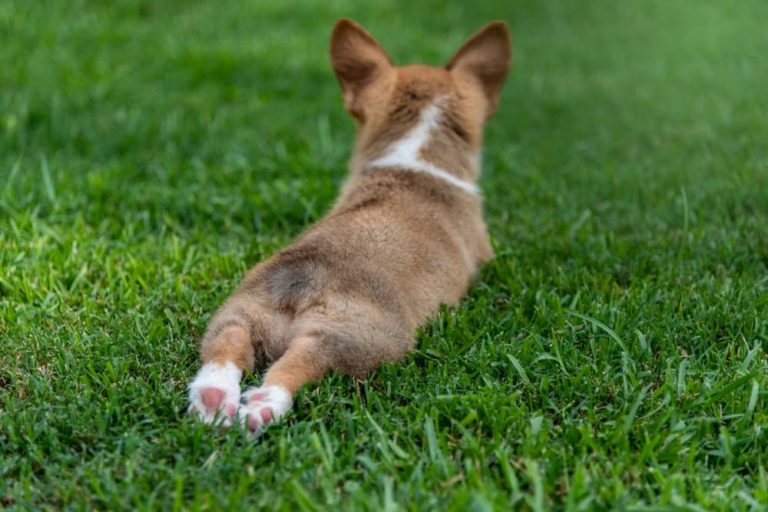Dog Splooting: Is It a Cause for Concern?

Whether your own pup does it or you’ve seen it on your Instagram feed, dog splooting is a term people have coined to describe the way an animal lies on the floor with its hind legs stretched out behind it.
Also referred to as the “frog leg” position, splooting is extremely cute. But you might wonder if this position is normal or if it could be a cause for concern.
Read on for a comprehensive overview of dog splooting, including what it is, why dogs do it, and if it’s ever a sign of discomfort or a joint issue.
What Is Dog Splooting?
You probably didn’t know this funny position had a name, but splooting is fairly common among dogs. Splooting refers to a dog (or other animal) lying on their belly on the ground, with their rear legs extended straight back and flat against the ground.
Although the Corgi sploot may be the most recognizable, any breed of dog can sploot. In fact, splooting is not even unique to dogs. Cats, chipmunks, and squirrels do it, too. Splooting is also quite common in wild and domesticated rabbits.
Why Do Dogs Sploot?

The answer to the question of why dogs sploot is quite simple: because they like it! According to Dr. Peter Vogel, owner of the Animal Orthopedic Center in Anaheim, California, dogs lie in whatever position feels good to them.
Lying in the sploot position simply may feel comfortable to your dog. The position can provide a good stretch, and if the weather is hot, splaying out completely flat against the cold ground can help a dog cool off.
“We see it pretty often in brachycephalic breeds as a way to cool down,” says Alison Creighton, a registered veterinary technician supervisor for VCA Animal Hospitals in Lakewood, Ohio. “Their shorter muzzles and smushed faces can make it more challenging for them to regulate their body temperature when they get hot.”
When Is Splooting Bad for Dogs?
Some pet owners worry that if their dog is lying in the sploot position it might mean they have hip or joint issues. As it turns out, splooting because of dog hip dysplasia or dog arthritis is an unfounded worry. If your pup sploots a lot, it could actually mean that their hips are healthy. Young puppies often enjoy lying in the sploot position, likely due to the greater flexibility in their hips.
“It does not indicate a problem,” assures Dr. Vogel. “In fact, dogs with painful hips do not like their hips extended and would avoid laying stretched out.”
That said, if your dog develops a painful joint injury or condition, they may lie or sit differently than usual, and this can be a signal that something is not right. “Dogs with cruciate ligament ruptures tend to sit with the affected leg sticking out,” Dr. Vogel says. “Other symptoms are difficulty rising, difficulty sitting, sitting down on walks, and obvious limping.”
Creighton points out that you might see a dog with rear-end paralysis in the sploot position, but this is the result of dragging themselves along the ground. Aside from paralysis – which would be apparent to even a casual observer – splooting on its own does not usually indicate an injury or joint concern. However, if you see any of the other signs above, your dog might be in some pain.
Dog Splooting: What to Do If You’re Concerned

If, in addition to your dog splooting, you do notice signals of pain or discomfort (limping, difficulty standing up from a lying down position, reluctance to walk, sit, or stand, or sitting down during walks) it’s important to get your dog checked out by a veterinarian.
To prepare for your visit, write down the symptoms you’ve been noticing. If possible, take a video of your dog limping or struggling to rise from the ground.
“First, your veterinarian will perform a thorough physical exam,” Creighton explains. “This will include assessing the range or motion of your pet’s hips and joints. You may also notice your veterinarian lightly pushing each vertebra down your pet’s back. This is a noninvasive way to check for spinal arthritis.”
Your veterinarian might also recommend taking X-rays (radiographs) of your dog’s spine, hips, and/or knees. When taking X-rays to assess joints, it’s common for veterinarians to lightly sedate the pet. This might raise a bit of concern, but Creighton points out that there are some very good reasons to use sedation during X-rays.
“Sedating your pet for this process is your vet’s way to ensure that your pet is as comfortable and pain free as possible,” Creighton says. “To get the best possible images of your pet, it is very important for them to stay still. If they are experiencing joint pain, they will understandably want to resist doing this. There also can be a lot of stretching and joint manipulation to get proper images, which can be painful for pets with arthritis or a sudden injury.”
If an injury or joint disorder is causing your dog’s pain and discomfort, your veterinarian can recommend the proper treatment. Depending on the issue, that might include a medication to help relieve arthritis pain and inflammation, such as Carprofen, surgery, physical therapy, joint supplements, and/or a therapeutic diet.

Keeping Dog Joints Healthy
According to Dr. Vogel, several supplements are good for joint health, though he cautions against using human formulations. Talk to your veterinarian about giving your dog a joint health supplement that contains glucosamine and chondroitin, plus omega fatty acids, such as Dasuquin® Advanced Soft Chews for Dogs.

Creighton reminds us that one of the most important factors in healthy joints is keeping your pet at a healthy weight. “Excess weight will put strain on your pet’s joints and can exacerbate arthritis and discomfort,” she says. “It can also increase the risk of acute injuries, such as cruciate tears.”









